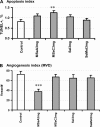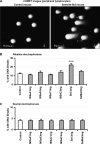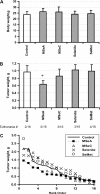Superior in vivo inhibitory efficacy of methylseleninic acid against human prostate cancer over selenomethionine or selenite
- PMID: 18310093
- PMCID: PMC3312608
- DOI: 10.1093/carcin/bgn007
Superior in vivo inhibitory efficacy of methylseleninic acid against human prostate cancer over selenomethionine or selenite
Abstract
Methylselenol has been implicated as an active anticancer selenium (Se) metabolite. However, its in vivo efficacy against prostate cancer (PCa) has yet to be established. Here, we evaluated the growth inhibitory effects of two presumed methylselenol precursors methylseleninic acid (MSeA) and Se-methylselenocysteine (MSeC) in comparison with selenomethionine (SeMet) and selenite in DU145 and PC-3 human PCa xenografts in athymic nude mice. Each Se was given by a daily single oral dose regimen starting the day after the subcutaneous inoculation of cancer cells. We analyzed serum, liver and tumor Se content to confirm supplementation status and apoptosis indices and tumor microvessel density for association with antitumor efficacy. Furthermore, we analyzed lymphocyte DNA integrity to detect genotoxic effect of Se treatments. The data show that MSeA and MSeC exerted a dose-dependent inhibition of DU145 xenograft growth and both were more potent than SeMet and selenite, in spite of less tumor Se retention than in the SeMet-treated mice. Selenite treatment increased DNA single-strand breaks in peripheral lymphocytes, whereas the other Se forms did not. Terminal deoxynucleotidyl transferase biotin-dUTP nick end labeling (TUNEL) and cleaved caspase-3 indices (apoptosis) from MSeC-treated tumors were higher than tumors from control mice or MSeA-treated mice, whereas the microvessel density index was lower in tumors from MSeA-treated mice. In the PC-3 xenograft model, only MSeA was growth inhibitory at a dose of 3 mg/kg body wt. In summary, our data demonstrated superior in vivo growth inhibitory efficacy of MSeA over SeMet and selenite, against two human PCa xenograft models without the genotoxic property of selenite.
Figures






References
-
- Jemal A, et al. Cancer statistics, 2006. CA Cancer J. Clin. 2006;56:106–130. - PubMed
-
- Petrylak DP. The current role of chemotherapy in metastatic hormone-refractory prostate cancer. Urology. 2005;65:3–7. discussion 7–8. - PubMed
-
- Clark LC, et al. Effects of selenium supplementation for cancer prevention in patients with carcinoma of the skin. A randomized controlled trial. Nutritional Prevention of Cancer Study Group. JAMA. 1996;276:1957–1963. - PubMed
-
- Lippman SM, et al. Designing the Selenium and Vitamin E Cancer Prevention Trial (SELECT) J. Natl Cancer Inst. 2005;97:94–102. - PubMed
-
- Ip C. Lessons from basic research in selenium and cancer prevention. J. Nutr. 1998;128:1845–1854. - PubMed
Publication types
MeSH terms
Substances
Grants and funding
LinkOut - more resources
Full Text Sources
Other Literature Sources
Medical
Research Materials

